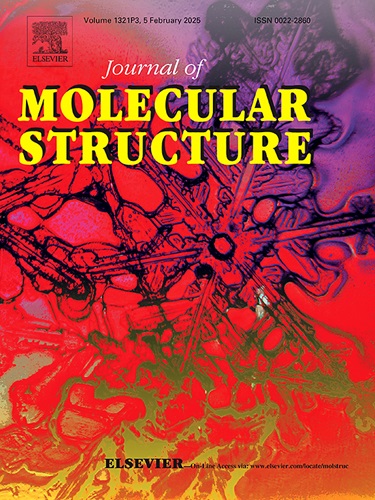Synthesis, antioxidant, antidiabetic, molecular docking and ADMET evaluation of indenoquinoxalines-carbazides compounds
IF 4
2区 化学
Q2 CHEMISTRY, PHYSICAL
引用次数: 0
Abstract
In this study, we report the synthesis of indenoquinoxalines heterocycles linked to carbazides moiety, including thiosemicarbazides, semicarbazides, and aminoguanidines. The structure of the compounds was confirmed using various spectroscopic techniques, such as 1H NMR, 13C NMR, FT-IR spectroscopy, and mass spectrometry. The synthesized compounds were then evaluated for their antioxidant activities using the DPPH and CUPRIC methods. The results demonstrated that our compounds exhibited satisfactory antioxidant potential, with compound 5c surpassing ascorbic acid in reducing power as evaluated by the CUPRAC with A0.50 = 0.070 ± 0.018 mg/mL. Furthermore, the in vitro antidiabetic activity measured by determining the glucose uptake using the yeast cells has shown promising results with absorption percentages ranging from 12 to 84 % using different concentrations of glucose, suggesting an interesting potential for blood glucose control. Molecular docking study demonstrated the potential of these molecules as potential α-glucosidase inhibitors. By showing a superior stability of all the enzyme-ligand complexes formed compared to the reference molecule, acarbose. Additionally, drug-likeness parameters, along with ADMET properties, were evaluated, suggesting a favorable pharmacokinetic profile for our compounds.
茚地喹啉-咔嗪类化合物的合成、抗氧化、降糖、分子对接及ADMET评价
在本研究中,我们报道了吲哚喹啉类杂环化合物的合成,包括氨基脲类、氨基脲类和硫代氨基脲类。化合物的结构通过各种光谱技术得到证实,如1H NMR, 13C NMR, FT-IR光谱和质谱。然后用DPPH和CUPRIC方法评价合成的化合物的抗氧化活性。结果表明,化合物5c的还原能力优于抗坏血酸,其还原能力为A0.50 = 0.070±0.018 mg/mL。此外,通过测定酵母细胞的葡萄糖摄取,体外抗糖尿病活性显示出有希望的结果,在不同浓度的葡萄糖下,吸收百分比从12%到84%不等,这表明了血糖控制的有趣潜力。分子对接研究证实了这些分子作为α-葡萄糖苷酶抑制剂的潜力。通过与参考分子阿卡波糖相比,所有形成的酶配体复合物具有优越的稳定性。此外,我们还评估了药物相似参数以及ADMET特性,表明我们的化合物具有良好的药代动力学特征。
本文章由计算机程序翻译,如有差异,请以英文原文为准。
求助全文
约1分钟内获得全文
求助全文
来源期刊

Journal of Molecular Structure
化学-物理化学
CiteScore
7.10
自引率
15.80%
发文量
2384
审稿时长
45 days
期刊介绍:
The Journal of Molecular Structure is dedicated to the publication of full-length articles and review papers, providing important new structural information on all types of chemical species including:
• Stable and unstable molecules in all types of environments (vapour, molecular beam, liquid, solution, liquid crystal, solid state, matrix-isolated, surface-absorbed etc.)
• Chemical intermediates
• Molecules in excited states
• Biological molecules
• Polymers.
The methods used may include any combination of spectroscopic and non-spectroscopic techniques, for example:
• Infrared spectroscopy (mid, far, near)
• Raman spectroscopy and non-linear Raman methods (CARS, etc.)
• Electronic absorption spectroscopy
• Optical rotatory dispersion and circular dichroism
• Fluorescence and phosphorescence techniques
• Electron spectroscopies (PES, XPS), EXAFS, etc.
• Microwave spectroscopy
• Electron diffraction
• NMR and ESR spectroscopies
• Mössbauer spectroscopy
• X-ray crystallography
• Charge Density Analyses
• Computational Studies (supplementing experimental methods)
We encourage publications combining theoretical and experimental approaches. The structural insights gained by the studies should be correlated with the properties, activity and/ or reactivity of the molecule under investigation and the relevance of this molecule and its implications should be discussed.
 求助内容:
求助内容: 应助结果提醒方式:
应助结果提醒方式:


